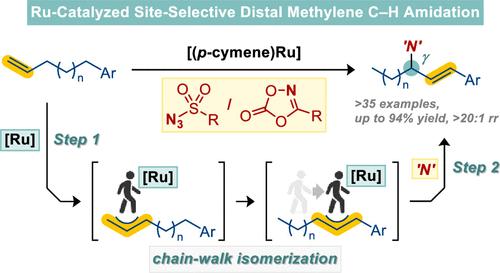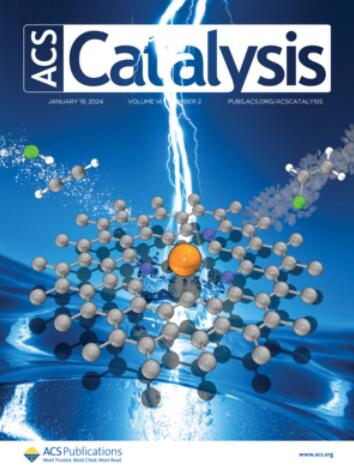Ruthenium-Catalyzed γ-Selective Intermolecular Amidation of Nonactivated Distal Methylene C–H Bonds of Terminal Alkenes via Olefin Chain-Walking Isomerization
IF 11.3
1区 化学
Q1 CHEMISTRY, PHYSICAL
引用次数: 0
Abstract
Here we report the development of the [(p-cymene)Ru(II)]-catalyzed γ-selective intermolecular amidation of nonactivated distal methylene C–H bonds of terminal alkenes using sulfonyl azides and dioxazolones as the nitrogen sources. Initiated by the π-allyl Ru(II) complexes formation, the ruthenium complexes undergo spontaneous chain-walking isomerization via proton-assisted 1,3-allyl migration along the hydrocarbon chain. For alkenes containing a distal aryl substituent, the chain-walking isomerization afforded the aryl-conjugated alkenes as the most dominant isomerized products. With sulfonyl azides as the nitrogen source and the [(p-cymene)Ru] catalyst, the aryl-conjugated alkenes were further converted to the corresponding allyl tosylamides with >20:1 γ-selectivity. Unlike those cases with sulfonyl azide as the nitrene source, the analogous amidation with dioxazolones afforded the corresponding allylcarboximides in ca. 5:1 γ-selectivity. The nature of the chain-walking alkene isomerization and the origin of the γ-selectivity have been delineated.

求助全文
约1分钟内获得全文
求助全文
来源期刊

ACS Catalysis
CHEMISTRY, PHYSICAL-
CiteScore
20.80
自引率
6.20%
发文量
1253
审稿时长
1.5 months
期刊介绍:
ACS Catalysis is an esteemed journal that publishes original research in the fields of heterogeneous catalysis, molecular catalysis, and biocatalysis. It offers broad coverage across diverse areas such as life sciences, organometallics and synthesis, photochemistry and electrochemistry, drug discovery and synthesis, materials science, environmental protection, polymer discovery and synthesis, and energy and fuels.
The scope of the journal is to showcase innovative work in various aspects of catalysis. This includes new reactions and novel synthetic approaches utilizing known catalysts, the discovery or modification of new catalysts, elucidation of catalytic mechanisms through cutting-edge investigations, practical enhancements of existing processes, as well as conceptual advances in the field. Contributions to ACS Catalysis can encompass both experimental and theoretical research focused on catalytic molecules, macromolecules, and materials that exhibit catalytic turnover.
 求助内容:
求助内容: 应助结果提醒方式:
应助结果提醒方式:


